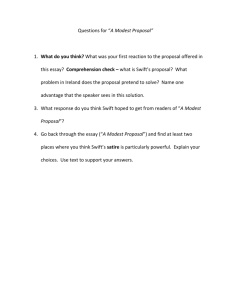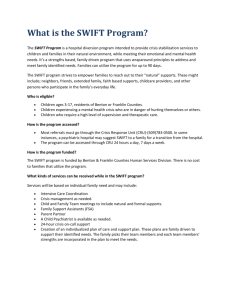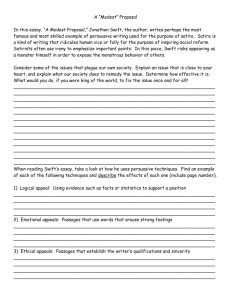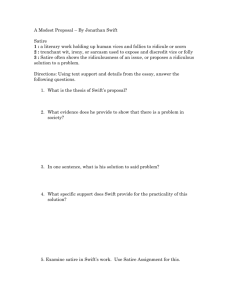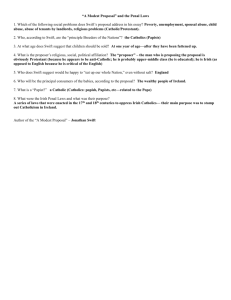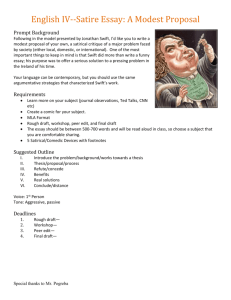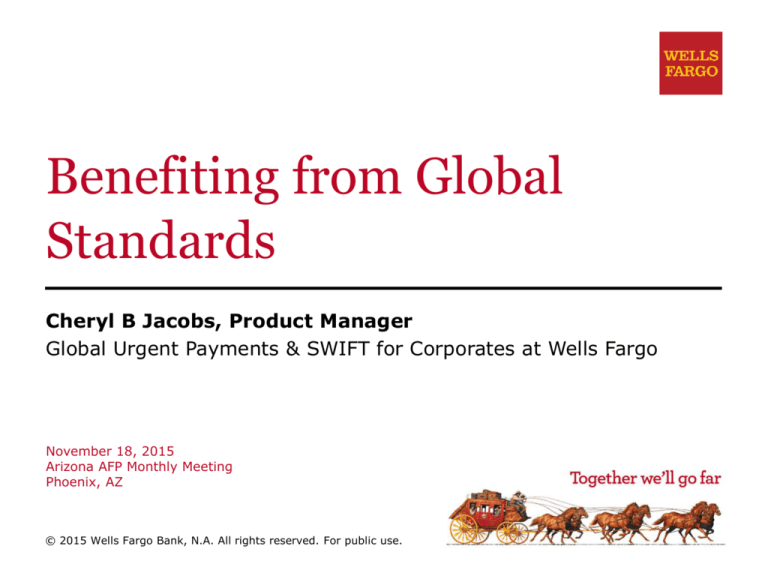
Benefiting from Global
Standards
Cheryl B Jacobs, Product Manager
Global Urgent Payments & SWIFT for Corporates at Wells Fargo
November 18, 2015
Arizona AFP Monthly Meeting
Phoenix, AZ
© 2015 Wells Fargo Bank, N.A. All rights reserved. For public use.
Agenda
What is SWIFT and global standards?
Who is using SWIFT and global standards?
What does it really mean? What are we seeing in the
industry?
What are the benefits and considerations to using?
Dispelling the myths
How do I start?
What does success look like?
1
About SWIFT
10,000+
customers in over
212
countries
20 million+
messages per day
99.999%
A cooperative serving the
financial industry since
1973
A provider of highly
secure Financial
Messaging services
A financial
standardization
organization
availability
Source: SWIFT: How can SWIFT work for you? Aug 2014
2
SWIFT: A single standardized gateway
Multiple bank channels
Single, standardized gateway
Corporate
Corporate
VAN
Accounts
payable
Accounts
receivable
Accounts
payable
host-to-host X
Leased
line
Treasury
Other
Accounts
receivable
Treasury
Other
e-banking Y
Standardized
gateway
Internet
e-banking Z
High cost
Lower cost
No global visibility on cash
Transparency and view on cash
Impossible to centralise
Increased control and security
Challenge of multiple connectivity
channels and formats
Reduced risk
Source: SWIFT: How can SWIFT work for you? Aug 2014
3
Benefits of global standards
Universal format
Ease of implementation
Prepares for global expansion
Data management – from “big” data to “better” data
Supports automation
Allows to redeploy resources toward more strategic
planning
Lower costs – elimination of multiple data portals,
duplicate data downloads
Provides for enhanced controls and compliance
4
Who is looking to use SWIFT or global standards?
US based company looking to streamline
US based company who is expanding in Asia and
Europe
US based company who uses 3 banks and multiple
connection points – such as 2 online portals and one
host-to-host transmission
US subsidiary whose parent company already uses
SWIFT
Others….
5
But also….
I’m being asked to reduce costs, eliminate redundant
access, downloads and reports
We are upgrading our ERP system and our vendor
has this “SWIFT” module
We are in an RFP process to look at SAP or oracle or
another automation system
We want to improve our processes
We are expanding our business into xx country and
am not sure where to start
We are thinking about expanding globally
We need to automate file generation and receipt that
supports risk and controls
6
Why should I consider global standards?
We’re all being asked to do more with less; think
strategically and optimize how we do things
Cost savings – optimize and standardize the formats that you
use to send payments, receive information and reconcile
Standardize – use one format instead of multiple connection
points, multiple formats and
Support or prepare for expansion – countries outside of the
United States don’t use BAI or NACHA. Changing to a global
standard allows you to more easily expand into other
countries
7
What’s happening in the industry with
standardization
ISO format
is becoming the
global standard
Single Euro Payments Area (SEPA)
payments must be initiated to/from
accounts in the Euro zone
NACHA is working on support for ISO 20022
XML
Global support for ISO20022 XML
Global interoperability
TARGET2 (Euro zone) is planning a phased
implementation of ISO 20022
Regulation, industry consensus and
customer demand key factors
Canada Payment Association (CPA) and the
US Federal Reserve are working to figure
out how/when to support ISO 20022 XML
8
Benefits and considerations
Benefits
More effective management of
global cash and financial
transactions via a standardized
and centralized process
Lower total cost of ownership for
communicating with banking
partners
Enhanced straight through
processing and automatic
reconciliation
Supports global regulatory
compliance and reporting
Standardization and global
business process
Considerations
Need for upfront costs to update
systems, map data and new
formats
Willingness to do things differently
Ability to send and receive
transmissions
9
Dispelling the myths…
Myth
Reality
Only for banks
Secure networking connecting the global financial
community including corporations, banks, securities
firms and market infrastructures
The costs are high
SWIFT offers cloud-based solutions for low costs
Only for international flows
Domestic and international transaction flows
supported
Only supports SWIFT standards
Carries SWIFT and non-SWIFT formats securely
Only for publicly listed companies
For publicly listed and privately held companies
sponsored by members
Only for very large companies
41% of Corporate members have <$1 Billion
in revenue
ISO 20022 XML is plug-and-play
Actually, while there is ease of use and flexibility with
ISO 20022 XML, it is not as easy as just starting
ISO 20022 XML pain and SEPA
are the same
SEPA has adopted the ISO 20022 XML pain
standards, but they are two different items
I’m set once I implement ISO with
one bank
While ISO 20022 XML is a standard, each bank may
have slight differences
Source: SWIFT for Corporates 2015
10
What are my options?
Embrace SWIFT, Global Formats or both
Start small – change your transmission method to be
standard, the rest can follow
Medium – change the transmission and format with one
bank partner
Go Big – change your connections and format with all
bank partners
11
Planning your project
Define project scope
Select which
services –
payments,
reporting, etc.
Select which
banks you
want to start
with
Evaluate your
technical
environment
Contact bank
and partners
Talk with and
select a
partner –
service
bureau
Talk with your
banks
Agree on
SLAs and
operational
procedures
Select the
components
Select how
you want to
connect to
SWIFT,
partners and
banks
Determine
how you want
to integrate
Implement
and test
Rollout and
go live
Join SWIFT
Train your
Install
Switch to live
Retire your
and order
components
hardware and
software
Enable test
environment
staff
proprietary
connections
Monitor traffic
flows
12
Our most successful customers do this…
Have a desire to streamline and simplify their bank
connections and processes
Dedicate/identify resources to work and manage their
SWIFT and ISO 20022 XML efforts
Including business lead, technical lead, testing
resources
If a vendor is involved, vendor lead
Ability to generate and consume test files
Have senior leadership commitment and support to
“think about things differently”
Ability to front-load costs
13
What leads to a less-successful implementation?
Doing too many things at the same time
Often we see customers who are implementing SAP,
Oracle and SWIFT at the same time
Viewing SWIFT and ISO 20022 XML as a side project
or “hobby”
Not fully understanding the formats
Not prepared to test
Resistance to change
14
Implementation strategies for success
Define your end goal – what processes will improve?
Determine if going direct or through a service bureau is
right for your organization.
Layout an implementation plan – region by region?
Obtain buy-in within your organization. Has to be
agreement to go to SWIFT or with a global format
standard.
Have dedicated resources for implementation.
Identify a business and technical representative
assigned to your implementation.
15
How do we work together?
Partner with your banks – working together helps
everyone
Ask your bank partners for their capabilities
Challenge us to look at things differently, as you look
at ISO 20022 XML so are we
Be willing to review and provide feedback
Share your pain points and strategy
16

